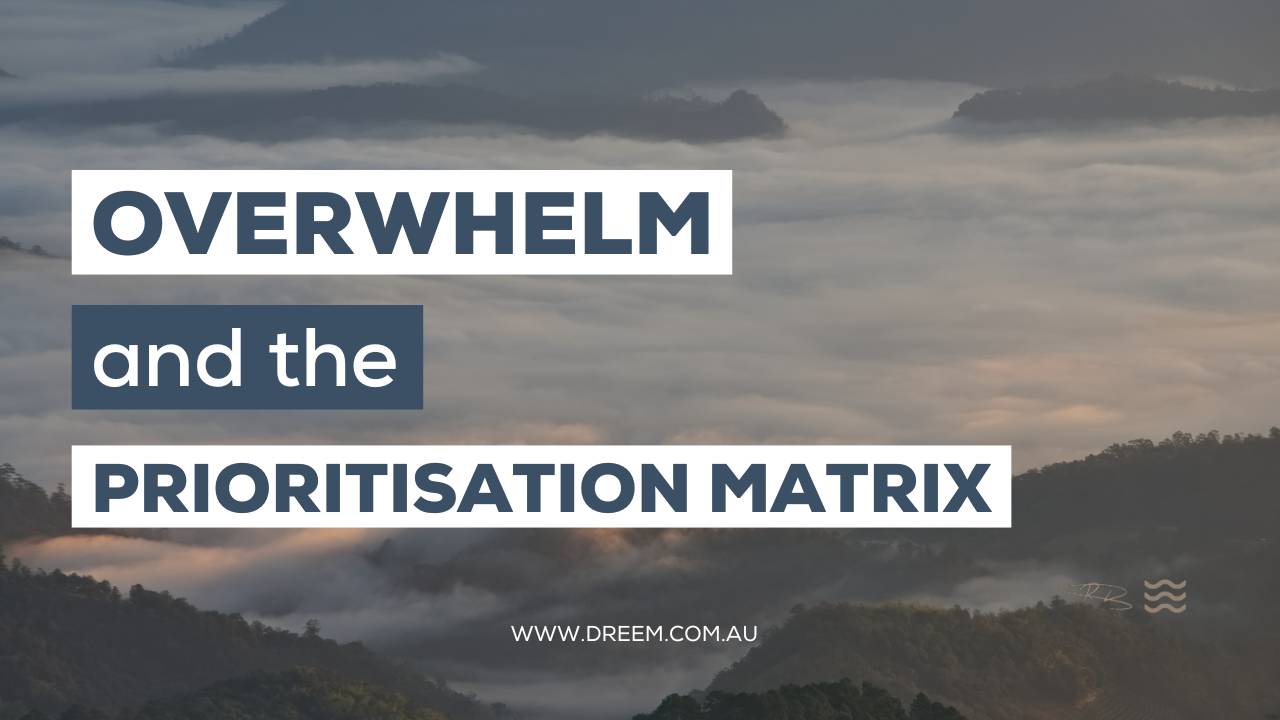
Overwhelm and the Prioritisation Matrix
It’s so easy to find ourselves juggling multiple tasks and responsibilities, leading to a sense of overwhelm. The sheer volume of work projects, personal commitments, and breaking it all down to the common denominator can be daunting. This is where the Prioritisation Matrix can step in and bring order to chaos, and allow you to gain control.
Understanding Overwhelm
Overwhelm is a state of mental and emotional exhaustion caused by feeling unable to cope with the demands and pressures of life. It can manifest as a persistent feeling of being swamped, scattered, and unable to focus on specific tasks. When overwhelmed, we may struggle to make decisions, feel paralysed by the sheer volume of work, and experience a decline in productivity and overall well-being.
Enter the Prioritisation Matrix
The Prioritisation Matrix is a visual tool that helps us evaluate and prioritise tasks based on their urgency and importance.
It provides a structured approach to making decisions and allocating resources effectively. The matrix categorises tasks into four quadrants:
- Quadrant 1: Urgent and Important (Do First): Tasks in this quadrant are both time-sensitive and crucial. They require immediate attention and should be prioritised to avoid negative consequences or missed opportunities. Examples might include pressing deadlines, emergencies, or critical client requests.
- Quadrant 2: Not Urgent but Important (Schedule): This quadrant represents tasks that are important but not time-sensitive. They contribute to long-term goals, personal growth, and overall success. Examples include strategic planning, relationship-building, skill development, and proactive maintenance. Scheduling and allocating dedicated time to Quadrant 2 tasks can prevent them from becoming urgent and falling into Quadrant 1.
- Quadrant 3: Urgent but Not Important (Delegate): Tasks in this quadrant are time-sensitive but don't contribute significantly to your long-term goals. They often involve interruptions, distractions, or routine administrative work. Whenever possible, consider delegating these tasks to others, automating them, or finding ways to minimise their impact on your productivity.
- Quadrant 4: Not Urgent and Not Important (Eliminate/Minimise): This quadrant represents tasks that neither require immediate attention nor contribute to your long-term goals. They can include time-wasting activities, excessive social media use, or indulging in unproductive habits. Identifying and eliminating or minimising these tasks can free up valuable time and mental energy for more meaningful endeavours.
Review your day today. How many seconds, minutes, and hours did you spend in Quadrants 3 and 4? The chances are, it is probably the majority of the day. Think about it like this: if you are spending even just 2 hours a day in Quadrant 4, doing time-wasting activities that aren’t contributing anything to your long-term goals, then that equates to 65 full days a year of time wasted!
Using the Prioritisation Matrix gives us clarity in a number of areas, which enables us to achieve our goals with accuracy. These include:
- Enhanced Focus: The matrix helps clarify what truly matters and enables you to focus on tasks aligned with your goals and values. By tackling urgent and important tasks first, you can reduce the mental clutter and distractions that contribute to overwhelm.
- Improved Decision-Making: With a structured framework for evaluating tasks, you can make informed decisions about how to allocate your time and resources. By differentiating between urgent and important tasks, you can avoid getting caught in the "busyness" trap and prioritise what truly matters.
- Time Optimisation: By identifying and scheduling important but non-urgent tasks, you can proactively manage your time, ensuring that important projects receive adequate attention. This approach helps prevent last-minute rushes and reduces the likelihood of tasks becoming urgent and overwhelming.
- Reduced Stress: By prioritising tasks and eliminating non-essential activities, you can reduce stress levels and create a more balanced approach to work and life. The matrix empowers you to make intentional choices and avoid feeling constantly overwhelmed.
The Prioritisation Matrix is a valuable tool that empowers us to navigate overwhelming situations with greater clarity and purpose. By understanding the urgency and importance of tasks, we can make informed decisions, allocate our time and resources effectively, and focus on what truly matters. This structured approach helps us regain control, enhance productivity, and reduce stress levels.
Start your journey
Every day is a chance to make positive changes. Get in touch with Reem Borrows at Dreem Coaching & Consulting today to see how her custom-built workshops can help grow and develop your business and self to create lasting success.
To broaden your leadership capabilities, tune in to the Leaders Leading Leaders podcast available on Spotify, Apple Podcast, and Google Podcast, and visit dreem.com.au to begin achieving your dreams.
Connect directly with us
We hate SPAM. We will never sell your information, for any reason.



